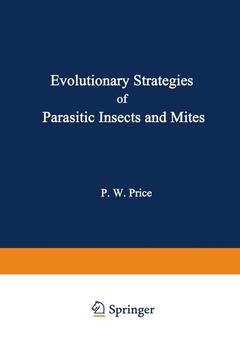Description
Evolutionary Strategies of Parasitic Insects and Mites, Softcover reprint of the original 1st ed. 1975
Coordinator: Price Peter
Language: English
Subject for Evolutionary Strategies of Parasitic Insects and Mites:
Publication date: 02-2012
224 p. · 17x24.4 cm · Paperback
224 p. · 17x24.4 cm · Paperback
Description
/li>Contents
/li>
This volume contains the invited lectures presented in a symposium entitled "Evolutionary strategies of parasitic insects and mites" at the national meeting of the Entomological Society of America in Minneapolis, Minnesota, 2-5 December, 1974. The intent was to bring together biologists who have worked on arthropods that are either plant or animal parasites in order to foster consideration of general aspects of the parasitic way of life. There seems to be a deficiency of ecological and evolutionary concepts relating to parasitism, in contrast to the burgeoning literature on predation, and it appeared that an amalgamation of studies on plant and animal parasites might help development of some generalities. Since parasities are far more numerous than predators in the world fauna, or in any particular community, emphasis on their study is justified. I freely admit that para sitoids have been usefully regarded as predators by ecologists, and many concepts on predation have been derived from their study. Also, in whichever category one places the parasitoids, that is the one which contains the most species. However, from an evolu tionary point of view they show many characteristics that must be regarded as those of a parasite. Notably, they are small, highly specific to their host, highly coevolved with it, as a result many species can coexist, and their adaptive radiation has produced the majority of the species diversity seen on Earth today.
Page.- The Parasitic Way of Life and its Consequences.- Approaches to the study of parasitic arthropods.- Evolutionary consequences of the parasitic habit.- Consequences for the parasite.- Consequences for the host.- Conclusions.- Some Components in an Evolutionary Biology of Parasites.- Biochemical Coevolution between Parasitoids and their Hosts.- Habitat preference.- Habitat location.- Host searching.- Parasitoid conditioning.- Host acceptance.- Host identification.- Host discrimination.- Host suitability.- Host regulation.- Summary.- Models for Parasite Populations.- Population models.- Examples of m-parasites.- Evaluation of m-parasites.- Darwinian models.- Conclusions.- Courtship in Parasitic Wasps.- Patterns in courtship: two examples.- Courtship and reproductive isolation.- The elements of courtship.- Pheromonal attractants in parasitic wasps.- Male wing vibration during courtship.- Role of antennae during courtship.- Courtship strategies.- Summary.- Reproductive Strategies of Parasitoids.- Determinants of parasitoid fecundity.- Host survivorship curves.- Ovariole number and fecundity.- Adaptations of reproductive organs and larvae 92 Ovariole number and characteristics of host attacked.- Ichneumonidae.- Tachinidae.- Summary.- Consequences of Parasite and Host Characteristics on Community Organization and Speciation.- Succession of r and K Strategists in Parasitoids.- Theory of r and K selection.- Studies revealing r and K selection 116 Development of v and K strategists in communities 117 Evidence of r and K strategists among parasitoids.- Summary.- The Organisation of Chalcid-Dominated Parasitoid Communities Centred upon Endophytic Hosts.- The oak gall community.- Discussion.- The leaf-mine community.- Discussion.- General Discussion.- Summary.- Interactions of Seeds and their Insect Predators/ Parasitoids in a Tropical Deciduous Forest.- Definitions.- Dense versus diffuse populations.- Numbers of pods per tree.- Numbers of seeds per pod.- Percent seeds dying.- Carrying capacity.- Resource size of adult host plants.- Concentrations of adults.- Avoid thy neighbor.- Host specificity.- Hyperparasitoids.- Surviving the inimical season.- Disturbance.- Sympatric Speciation in Phytophagous Parasitic Insects.- Some important aspects of Rhagoletis biology.- Patterns of evolution.- The genetics of host shifts 193 A generalized genetic model of sympatric speciation.- Summary.- Author Index.- Genus and Species Index.- Subject Inde.
© 2024 LAVOISIER S.A.S.




